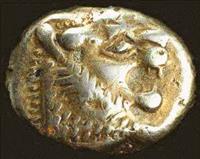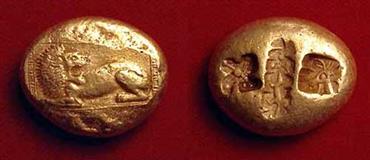2,700 years of history
The heritage of ancient coins is a subject that intrigues and delights collectors and scholars
the world over. The oldest coin available today was discovered in Efesos, an ancient Hellenic city and prosperous
trading center on the coast of Asia Minor. The 1/6 stater, pictured below, is more than 2,700 years old, making
it one of the very earliest coins. Made from electrum, a natural occuring alloy of gold and silver, the coin
originated in the area of Lydia. It had a design on one side only, a result of the primitive method of manufacture.
This ancient stater was hand struck. A die with a design (in this case a lion's head) for the obverse (front) of
the coin was placed on an anvil. A blank piece of metal was placed on top of the die, and a punch hammered onto
the reverse. The result was a coin with an image on one side and a punch mark on the other.

The stater is a key exhibit in the Department of Coins and Medals of the British Museum, which
houses one of the world's finest numismatic collections, comprising about 1 million objects. The earliest issues,
thought to date from the reign of Alyattes (about 610 - 560 BC) or perhaps his predecessor Sadyattes - both of the
Mermnad dynasty - feature the Lydian kings' emblem of a roaring lion, almost always with a curious knob, often
called a "nose wart," on its forehead.
Electrum
Lydia does not have many marvelous things to write about in comparison with other countries,
except for the gold dust that is carried down from Mount Tmolus.
- Herodotus, The History, 1.93
The Pactolus River beside the slopes of Mount Tmolus in the kingdom of Lydia was one of the most important
sources of electrum in the ancient world. According to Greek mythology, the river acquired its electrum when King
Midas of nearby Phrygia bathed in it to wash away his golden touch, which had turned even his food into gold, a
telling parable about the destructiveness of wealth. In actuality, The Paktolos River acquired its electrum from
electrum-laden quartz deposits near Mount Tmolos (called Mount Bozdag today).
The alluvial deposits of gold were mixed with as much as 40% silver and some copper; such a gold-silver mix is
called electrum. The earliest coins were made of electrum with a standardized 55% gold, 45 silver and 1-2% copper
concentration and had either no design or a some apparently random surface striations on one side and a punch
impression on the other.
Just as the rulers of the Middle East today have become wealthy from oil, so the ancient Lydian kings became
rich by accumulating and minting coins from electrum. The capital city of ancient Lydia was Sardis, and it was a
major commercial center linking the Asian kingdoms of the east with the coastal Greek cities of Ionia, including
Miletus. It is not an accident that the first coins appeared in the important commercial centers of Lydia and
adjacent Ionia, nor that the first system of bimetallic currency - the first system of interrelated gold and silver
issues - was also developed there. As the 19th century German historian Ernst R. Curtius wrote, "The Lydians became
on land what the Phoenicians were by sea, the mediators between Hellas and Asia."
Electrum Stater Of Miletos
The most famous coin type of ancient Miletus, and one of the earliest of all coins that can be attributed to a
particular city, is the electrum stater that features a crouching lion regardant on the obverse, and three incuse
punches on the reverse. Although they are not excessively rare, these electrum staters (weighing just over
fourteen grams) are understandably very expensive. The fourteen-gram staters, however, represent only one
denomination in a complete denominational series that also included thirds, sixths, twelfths, and twenty-fourths
of a stater, and perhaps smaller denominations as well. These lesser denominations, not surprisingly, command
less stratospheric prices.

Several Greek cities, including Miletos, as well as the Lydian kings began minting these first coins by
stamping the badge of their city into one side of a standard weight lump of electrum and various punches into the
other. These devices were used to facilitate trade by certifying that the intrinsic value and weight of the metal
was guaranteed by the issuing authority. Of these first coins, those of Miletos like the current example
(600-550 BC), are probably the finest from an artistic perspective. The lion, cleverly configured
with its head reverted and tail curled over its haunch to neatly fit within the rectangular frame, is a
masterpiece of Archaic Greek art. The vigor and ferocity of the beast are beautifully conveyed by its snarling
countenance and erect mane. Mean Diameter: 21 x 17.5 mm. (0.827 x 0.689"). Weight: 13.91 gm. (0.435 Troy oz.)